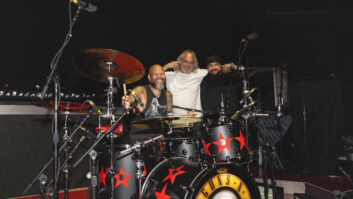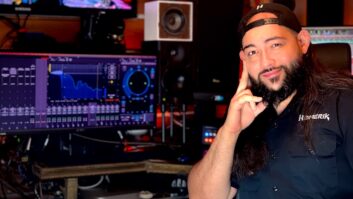Sifl ‘n’ Olly, a show peopled by ragamuffin sock puppets with a soundtrack that’s literally recorded in a kitchen, fits in with MTV’s minimalist leanings; in addition to costing virtually nothing to manufacture, it not only looks like it was made for adolescents but also made by them. But its very simplicity also recalls the early days of children’s television programming. If paths had crossed at a different time, it could have Shari Lewis and Lambchop up there every night, singing about carrots and reprising Blue Oyster Cult’s “Don’t Fear the Reaper.” On Sifl ‘n’ Olly, life’s lessons are conveyed in a way that straddles the line between the childish and the childlike.
Sifl ‘n’ Olly creators Matt Crocco and Liam Lynch started dreaming up comedy together when they were in the seventh grade in Ohio. They would make up show formats and record them to a cassette boom box, complete with songs off records as their backdrop. They were prefigurations of Beavis and Butt-head, sans music videos to criticize. “The names are totally meaningless,” says Crocco of Sifl ‘n’ Olly. “We would just sit around making them up then like we do now, and we picked two names from back then.”
The two continued to make their brand of ad hoc comedy cassettes as they grew up, and as the small but loyal core of fans they played them for grew, so did their technology, graduating to a 4-track cassette deck. Both Crocco and Lynch eventually landed in Nashville. Lynch went off to college in Europe, and while at the Liverpool Institute for the Arts in 1995, he took one of the tapes, edited it and married it to a VHS tape of some sock puppets as a Christmas gift for his partner back in the States. He also sent a copy of it to MTV Europe, which promptly asked for more one-minute snippets to run between videos and shows.
But the real payoff came through persistence. After four months of phone calls, one finally made it through to Brian Graden, the executive behind South Park and the new president of programming for MTV (USA). Sifl ‘n’ Olly, the product of two fertile, young minds, was about to make the transition from home video to big-time broadcast. But in doing so, they were able to maintain DIY production values that gave the show its character. Integral to the process was their relationship with Nashville engineer and music producer Brian Hardin.
Crocco and Lynch had become friends with Hardin from their early days in Nashville. They affectionately refer to him as The Enabler because he seems to share their affinity for randomness and innocent comedy, and his slacker-esque philosophy and auteur approach to music production proved a good fit. The Washington, D.C., native had come to Nashville 16 years before to attend Belmont University’s recording program, where he eventually became student studio manager and producer/engineer on nearly 1,000 songs (including a few with then-up-and-coming artists such as Pam Tillis and Little Texas) over the course of the four-year program.
Upon leaving school, Hardin did some typically Nashville sorts of sessions with artists like Jerry Lee Lewis, Hank Williams Jr., George Strait and Kenny Rogers, as well as lots of Christian records and a few pop records with Ziggy Marley, Steve Winwood and Belly. The predictability of most of that music soon wore thin for him, however, and, as he puts it, he “abandoned all need for security and invested in producing music that was a lot less predictable, like punk, alternative rock, dance music, hip hop and rap.” But Hardin seems to have hit his stride with Sifl ‘n’ Olly’s creators. “There is nothing anal-retentive about the audio to this show, or any other aspect of it, for that matter,” he explains. “Making things sound perfect or using traditional techniques always takes a back seat to allowing randomness and creativity to come through.” His mottos: “Most great inventions are created by accident”; “Creativity should be emotional and free-flowing, not logical and contrived”; “I strive for progress rather than perfection.”
CHEAP ‘N’ CHEESY IS FUNNYSifl ‘n’ Olly is recorded in two ad hoc studios in Hardin’s home on Nashville’s west side. The songs are recorded in the kitchen, which looks like a cartoon of a pimped-out whorehouse, complete with spinning disco ball and jalapeno lights; dialog is done in the basement, which has just a bit more isolation. “We’re not too worried about things like leakage,” says Hardin. “On the downbeat of the very first show, there’s the sound of a car peeling out. That came in through an open window while we were recording the song, and we just left it there. In fact, we made it louder.” It’s not unusual to hear the occasional telephone ring buried in a track.
In addition to a stove and refrigerator, the 20×12-foot kitchen-chosen because Hardin says it’s the best-sounding room in the house-has a Yamaha 02R digital console and 32 tracks of Tascam MDMs (one DA-88 and three DA-38s), with KEF C55, Sentry 100 and Yamaha NS-10 monitors. The 34×17-foot living room is filled with a ’70s Gretsch drum kit, Mallory upright grand piano, ’70s Yamaha portable organ with a ribbon slide bar, vintage tube Leslie, and many other guitars, amps and percussion instruments. The 25×17-foot basement studio has an old Fostex 450 console, which Hardin thinks is one of the funniest pieces of equipment ever made. “It should have ‘Mattel’ written on it,” he says. “If it ever caught fire it would produce toxic fumes.” On the other hand, he notes, “There’s a certain musicality in cheesy gear. It has a 3-band parametric EQ with a well-placed Q that any idiot can grab and make sound good. Great gear can make things sound clean and professional, but you don’t need top-of-the-line equipment to make things sound interesting and flavorful.”
That sentiment is reflected in the rest of the Sifl ‘n’ Olly audio arsenal, much of which is stored in kitchen drawers. Basic tracks and the songs themselves are generally constructed simultaneously. Spontaneity is the key to the show’s humor. The trick is to be capable of recording any instrument within seconds. Crocco (Sifl) and Lynch (Olly) will pick one of the half-dozen Casio or Yamaha keyboards lying around the room. They’ll randomly choose a preset, musical style and tempo from the collection of onboard parameters, and play a few chords, making up lyrics as they go along, much the same way they did 20 years earlier as kids. Songs are typically written, produced, recorded, overdubbed and rough-mixed within 30 minutes. “No one has any idea what’s going to come out,” says Hardin (whose predilection for both the bizarre and the cheap is evident in a record he produced recently for a 7-foot-tall rapper named Cheze Boy and in the tentative name of the studio, The Cottage Cheese). “All they know is, they’re writing a song about carrots. Every piece of equipment is simply a creative catalyst.”
Hardin records everything. As he puts it, “Tape is cheap, and spontaneity is hard to come by.” On playback, they decide if the performance works; if not, they take another pass, or use it as the basis for overdubs-usually of equally offbeat and bizarre instruments, with a special fondness for children’s percussion toys and electronic instruments, elevating Fisher-Price products to the status of pro audio outboard equipment.
Hardin has used an assortment of classic microphones on their voices and instruments, though, and the venerable Shure SM58 is generally the choice. “It takes an enormous amount of abuse, and its proximity effect lets it go from very full-sounding to very thin very quickly,” he explains. “It’s a funny-sounding microphone.”
This on-the-fly process also allows for prolific output. In preparation for the new season, they recorded some 40-plus songs in a single week. Each song was surrounded by the show’s dialog, recorded in the basement studio and then edited in Pro Tools, in the kitchen. Crocco’s and Lynch’s voices are recorded straight to tape; an Alesis Midiverb is added during the mix to both Sifl and Olly, while guest voices always remain dry, with the exception of an SPX90 used as a vocal harmonizer. “The contrast between the lead socks and the other socks is very stark and bizarre onscreen, which is another way to make it funny,” Hardin says. “The SPX90 is a funnier harmonizer than an H3000 or the one on the 02R, just because the graininess of the converters is more electronic-sounding, offering a colorful, flavorful, cheesier sound.”
Rather than developing sonic layers, more complex sounds are created by stringing instruments through a series of effects-usually cheap ones, like guitar stomp boxes and small guitar amps. The kitchen is a dense amalgamation of instruments and black boxes, all within easy reach. “The whole thing is set up so that I can set up combinations of stuff in about 20 seconds,” Hardin says. “If one combination doesn’t do it, then I can have another combination up in another 20 seconds. The whole thing is about spontaneity. Having done all those low-budget sessions over the years certainly helps my speed.” Hardin also adds sound effects from a Sound Ideas library, using an Ensoniq ASR10, Cubase VST and Pro Tools. Mixing is through the 02R; mastering is through a TC Electronic Finalizer to a Sony timecode DAT.
Video recording is done, appropriately enough, at another “Crescent Fresh” home facility, this one in Los Angeles, where the audio is played back from the timecoded DATs. But post-production on Sifl ‘n’ Olly is as minimal as the show itself. What shows up on screens in prime time is pretty much straight out of the kitchen, with little technological garnish. A million dollars’ worth of pro audio equipment would be kind of incongruous with a bunch of singing socks, anyway.







